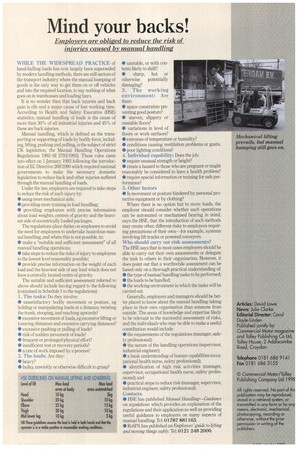Mind your backs!
Page 38

If you've noticed an error in this article please click here to report it so we can fix it.
Employers are obliged to reduce the risk of injuries caused by manual handling
WHILE THE WIDESPREAD PRACTICE of hand-balling loads has now largely been superseded by modern handling methods, there are still sectors of the transport industry where the manual humping of goods is the only way to get them on or off vehicles and into the required location, to say nothing of what goes on in warehouses and loading bays.
It is no wonder then that hack injuries and back pain is rife and a major cause of lost working time. According to Health and Safety Executive (HSE) statistics, manual handling of loads is the cause of more than 30% of all industrial injuries and 45% of these are back injuries.
Manual handling, which is defined as the transporting or supporting of loads by bodily force, including, lifting, pushing and pulling, is the subject of strict UK legislation, the Manual Handling Operations Regulations 1992–SE 2793/1992). These rules came into effect on 1 January 1993 following the introduction of EC Directive 269/1990 which required national governments to make the necessary domestic legislation to reduce back and other injuries suffered through the manual handling of loads.
Under the law, employers are required to take steps to reduce the risk of such injury by: • using more mechanical aids; • providing more training in load handling; • providing employees with precise information about load weights, centres of gravity and the heaviest side of eccentrically loaded packages.
The regulations place duties on employers to avoid the need for employees to undertake hazardous manual handling, and where this is not possible, to: • make a "suitable and sufficient assessment" of all manual handling operations; • take steps to reduce the risks of injury to employees to the lowest level reasonably possible; • provide precise information on the weight of each load and the heaviest side of any load which does not have a centrally located centre of gravity.
The suitable and sufficient assessment referred to above should include having regard to the following (contained in Schedule Ito the regulations): 1. The tasks: Do they involve: • unsatisfactory bodily movement or posture, eg holding or manipulating loads at a distance, twisting the trunk, stooping, and reaching upwards?
• excessive movement of loads, eg excessive lifting or lowering distances and excessive carrying distances?
• excessive pushing or pulling of loads?
• risk of sudden movement of loads?
• frequent or prolonged physical effort?
• insufficient rest or recovery periods?
• a rate of work imposed by a process?
2. The loads: Are they:
• heavy?
• bulky, unwieldy or otherwise difficult to grasp? • unstable, or with contents likely to shift?
• sharp, hot or otherwise potentially damaging?
3. The working environment: Are there:
• space constraints preventing good posture?
• uneven, slippery or unstable floors?
• variations in level of floors or work surfaces?
• extremes of temperature or humidity?
• conditions causing ventilation problems or gusts.
• poor lighting conditions?
4, Individual capability: Does the job: • require unusual strength or height?
• create a hazard to those who are pregnant or might reasonably be considered to have a health problem?
• require special information or training for safe performance? 5. Other factors • Is movement or posture hindered by personal protective equipment or by clothing?
Where there is no option but to move loads, the employer should consider whether such operations can be automated or mechanised bearing in mind, says the HSE, that the introduction of such methods may create other, different risks to employees requiring precautions of their own—for example, systems involving lift trucks or powered conveyors.
Who should carry out risk assessments?
The HSE says that in most cases employers should be able to carry out their own assessments or delegate the task to others irk their organisation. However, it does point out that a worthwhile assessment can be based only on a thorough practical understanding of: • the type of manual handling tasks to be performed; • the loads to be handled; • the working environment in which the tasks will be carried out.
Generally, employers and managers should be better placed to know about the manual handling taking place in their own organisation than someone from outside. The areas of knowledge and expertise likely to be relevant to the successful assessment of risks, and the individuals who may be able to make a useful contribution would include: • the requirements of the regulations (manager, safety professional); • the nature of the handling operations (supervisor, industrial engineer); • a basic understanding of human capabilities (occupational health nurse, safety professional); • identification of high risk activities (manager, supervisor, occupational health nurse, safety professional); and • practical steps to reduce risk (manager, supervisor, industrial engineer, safety professional). Contacts
• HSE has published Manual Handling—Guidance on regulations which provides an explanation of the regulations and their application as well as providing useful guidance to employers on many aspects of manual handling. Tel: 01787 881165.
• RoSPA has published an Employees' guide to lifting and moving things safely. Tel: 0121 248 2000.
HSE GUIDELINES ON Level of lift Head Shoulder
Elbow
Thigh
Mid lower leg NB These guidelines assume the load is held in both hands and that the operators in a stable position in reasonable working conditions. MANUAL LIFTING AND LOW" Max load Max load arms at body arms outstretched
10 kg 5kg
20 kg 10 kg
15k9 15 kg
20 kg 10 kg 10 kg 5 kg












































































































